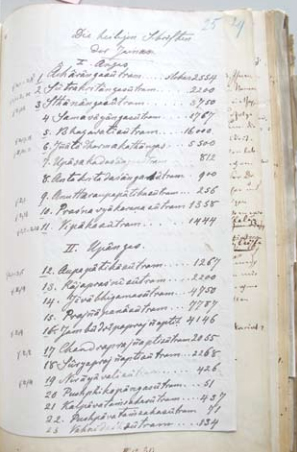
Centre of Jaina Studies Newsletter: SOAS - University of London
In 1873 Georg Bühler, then Education Inspector of the Bombay Presidency based in Surat, sent a letter to Albrecht Weber of the University of Berlin on 'The Sacred Scriptures of the Jainas' which detailed the Sanskrit titles of 45 Āgamas of the Mūrtipūjaka Śvetāmbara tradition under seven subheadings:
- 11 Angas,
- 12 Upângas,
- 10 Payannas,
- 6 Chhedasūtras,
- Nandīsūtram,
- Aṇuyogadvārasūtram,
- 4 Mūlasūtras.
The purpose of the letter, presented here for the first time (Figure 1),[1] was to provide information on the key texts of a literary tradition that was still almost unknown outside India to enable Weber to make recommendations for the purchase of selected Jaina manuscripts for the Royal Library in Berlin, with permission of the British authorities. Although its sources and history are not entirely clear, this list of the sacred scriptures of the Jainas was first published by Hermann Jacobi (1879: 14, n. 2)[2] and subsequently canonised in all modern handbooks (in one way or another: including or excluding texts lost or added before or after the last council).[3]
It has, however, frequently been noted that the number and contents of the 'canon' of the Śvetāmbaras, ostensibly codified in the 5th century at the council of Valabhī, were and still are in constant flux.[4] An early list of 45 somewhat similar titles has been traced in the Vicārasāraprakaraṇa, a 14th century text of Ācārya Pradyumnasūri. Yet, there is 'no tradition of the fixed established uniform titles'[5] as presented in modern textbooks and Āgama editions.[6]
The impact of Weber's letter on the emergence of contemporary textbook clichés of the Jaina tradition and its scriptures and the co-evolution of the field of Jaina Studies and Jaina modernism in the 19th and early 20th centuries demonstrates the significance of a better understanding of and the concerns and interactions of the pioneers of Jaina Studies in Europe such as Weber (1825-1901), Bühler (1837-1898), Hoernle (1841-1918), Pischel (1849-1908), Jacobi (1850-1937), Klatt (18521903), Hultzsch (1857-1927), Leumann (1859-1931), Winternitz (1863-1937), Hertel (1872-1955), Guérinot (1872-1929), Schubring (1881-1969), Alsdorf (19041978) and their Indian collaborators.

Figure 1 First page of Bühler's letter of 1873
Ernst Windisch's Geschichte der Sanskrit-Philologie und Indischen Altertumskunde. I-III (Strassburg: Trübner, 1917-1921) still remains the principal source of information on the early years of Jaina Studies. However, long-term inquiries by the present writer on the unpublished correspondence of European Jainologists and Jaina mendicants, which is preserved only in fragments in Indian and European archives,[7] have unearthed many previously unknown letters of the pioneers of Jaina studies, presumed lost; in particular in the Staatsbibliothek in Berlin,[8] which in 1907 received a significant number of letters of European Indologists specialising in Jaina Studies as part of the superb collection of selected autographs of important scientists and scholars of Ludwig Darmstaedter (1846-1927), who pursued the vision of assembling primary materials for the study of the historical development of the European sciences from the 16th century onwards.[9]
Of particular historical interest, but rare and more difficult to trace, is the correspondence between European scholars and their Jaina counterparts, in particular certain Mūrtipūjka Śvetāmbara monks such as Vijayānandasūri (1837-1897) and Vijayadharmasūri (1868-1922) and their representatives, as well as book sellers, who bought and sold Jaina manuscripts.[10]
The Centre of Jaina Studies at SOAS is currently preparing a research project on the surviving correspondence between western scholars of Jainism and with Jaina mendicants during the founding years of Jaina Studies which, once published, will provide direct insight into personal agendas and methods as well as the networks and institutional and political contexts contributing to the formation of a new field of study in Indology and the Study of Religions and the emergence of public (self-) awareness of a hitherto unknown 'religion'. The project builds on prior research at SOAS on the social history of modern Jainism and Jaina Studies on Jaina Law and the Jaina Community (AHRC Research Grant B/RG/AN9085/APN/16406) and Johannes Klatt's Jaina Onomasticon (Leverhulme Trust Research Grant RPG-2012-620) and will supplement similar studies on scientific correspondence between key figures of 19th century Indology and Jaina religious and social reformism.[11]

'Die heiligen Schriften der Jainas,' Königliche Bibliothek zu Berlin, Acta betr. Den Ankauf von Sanskrit Handschriften durch Herrn Professor Dr. Bühler in Surat, No. III.4.44 1872-, pp. 25-8.
In contrast to Weber, Jacobi incorrectly assumed at the time that 'Nirayāvalī' is a heading and not an independent text.
Cf. A. Weber, 'Über die heiligen Schriften der Jaina,' Indische Studien 16 (1883) 226; H. v. Glasenapp. Der Jainismus. Hildesheim: Georg Olms 1925, 92-8; W. Schubring, Die Lehre der Jainas. Nach den alten Quellen dargestellt. Berlin: Walter De Gruyter & Co., 1935, § 41 (46 texts); Muni Puṇyavijaya et al., 'Introduction,' Nandisuttaṃ and Aṇuogaddārāiṃ. Bambaī: Mahāvīra Jaina Vidyālaya, 1968, pp. 25f.; P. Dundas, The Jains. London: Routledge, 2002, pp. 73-6 (47+ texts); P.S. Jaini, The Jaina Path of Purification. Berkeley: University of California Press, 1979, pp. 47-9 (60 texts).
'[W]e do not possess even a list regarding the scriptures codified at the Valabhī council' (H.R. Kapadia, A History of the Canonical Literature of the Jainas. Ahmedabad: Shwetambar Murtipujak Jaina Boarding, 1941/2000, p. 66).
Muni Puṇyavijaya, 'A Note on Jaina Āgamas,' Paiṇṇayasuttāiṃ. Part I. Bambaī: Mahāvīra Jaina Vidyālaya, 1984, pp. 71f.; A. M. Bhojak, 'Introduction,' ibid., p. 76 n. 1 refers to the Vicārasāraprakaraṇa
See K. Bruhn 'Āvaśyaka-Studies I,' Studien zum Jainismus und Buddhismus. Ed. K. Bruhn & A. Wezler, Wiesbaden: Franz Steiner Verlag, 1981, p. 12.
New search engines such as Kalliope and the British Library India Office Private Papers Catalogue are increasingly helpful for the identification of rare letters and other private papers. See Verbundkatalog Nachlässe und Autographen. Staatsbibliothek zu Berlin. http://kalliope. staatsbibliothek-berlin.de/
Recent research at the Staatsbibliothek was rendered possible by a Fellowship of the Max Weber Centre of Advanced Cultural and Social Studies at the University of Erfurt 2012-13 and Leverhulme Grant RPG-2012-620.
Degering, H., K. Christ & J. Schuster. Aus der Handschriften-Abteilung der Preußischen Staatsbibliothek: Abhandlungen und Nachbildungen von Autographen; Ludwig Darmstaedter zum 75. Geburtstag dargebracht. Berlin: Breslauer, 1922.
Flügel, P. 'Changing Self-Perceptions: Reflections on the Social History of Modern Jainism,' The Jaina and the British. Keynote Lecture. Universität Tübingen, 19.2.2010.
Müller, F. M, The Life and Letters of the Right Honourable Friedrich Max Müller. Edited by his Wife. 2 Volumes. London: Longmans, Green & Co., 1902; Kirfel, W.d (ed.), Briefwechsel A.W. von Schlegel - Christian Lassen. Bonn: Cohen, 1914; Körner, J. (ed.), Briefe von und an A.W. Schlegel. 2 Vols. Zürich: Amalthea, 1930; Vira, R. (ed.), Letters to Vijayendra Suri. Bombay: Kashinat Sarak, Yashodharma Mandir, 1959; Zeller, G, "Rudolph von Roth als Schüler, Lehrer und Gelehrter im Spiegel von Briefdokumenten," Indienforschung im Zeitenwandel: Analysen und Dokumente zur Indologie und Religionswissenschaft in Tübingen. Ed. H. Brückner, K. Butzenberger, A. Malinar & G. Zeller, 91-120. Tübingen: Attempto-Verlag, 2003; Brückner, H. & G. Zeller (Ed.). Otto Böhtlingk An Rudolf Roth: Briefe zum Petersburger Wörterbuch 1852-1885. Bearbeitet von Agnes Stache-Weiske. Wiesbaden: Harrassowitz, 2007; Rocher, R. & L. Rocher. Founders of Western Indology: August Wilhelm Schlegel and Henry Thomas Colebrooke in Correspondence 1820-1837. Wiesbaden: Deutsche Morgenländische Gesellschaft / Harrassowitz Verlag, 2013
 Dr. Peter Flügel
Dr. Peter Flügel